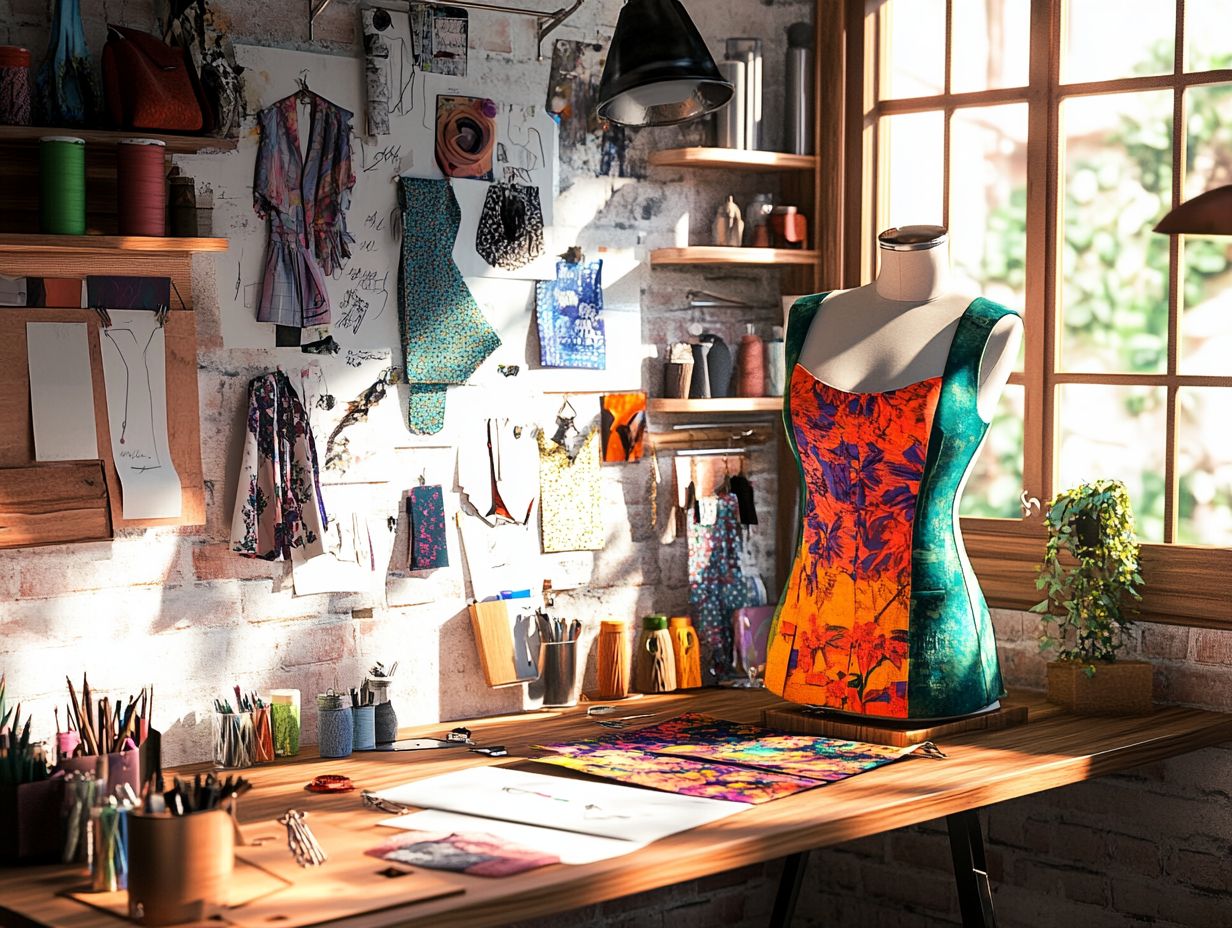Trade Secrets in Fashion: A Guide for Designers
In the fast-paced world of fashion, your success hinges on innovation and creativity. Protecting your unique ideas is just as important.
Trade secrets are essential for safeguarding the core of your brand, including everything from design concepts to manufacturing techniques and marketing strategies.
This article delves into the various types of trade secrets within the fashion industry. It emphasizes their significance and the legal ways available for you to protect them.
You will also learn best practices for keeping your information confidential and the potential risks associated with trade secret misuse. Dive into this essential topic and discover how it can elevate your fashion business!
Contents
- Key Takeaways:
- Understanding Trade Secrets in the Fashion Industry
- Types of Trade Secrets in Fashion
- Protecting Trade Secrets in Fashion
- How to Keep Trade Secrets Safe
- Consequences of Trade Secret Misuse
- Frequently Asked Questions
- What are trade secrets in fashion and why are they important for designers?
- How can designers protect their trade secrets in the fashion industry?
- Can trade secrets be patented in the fashion industry?
- How long do trade secrets last in the fashion industry?
- What are the potential consequences of trade secret theft in the fashion industry?
- Are there any alternatives to trade secrets for protecting designs in the fashion industry?
Key Takeaways:

Trade secrets are confidential pieces of information that give designers a competitive edge.
Types include design, manufacturing, and marketing secrets.
Misuse can lead to serious legal issues and harm your brand’s reputation.
Understanding Trade Secrets in the Fashion Industry
Trade secrets hold immense significance in the fashion industry, acting as invaluable assets that enhance a brand’s market presence and safeguard its distinctive identity.
These proprietary elements include formulas, processes, designs, and techniques, which are essential for maintaining a competitive advantage.
For you as a fashion designer or stakeholder, grasping the intricacies of trade secrets is crucial for navigating the complexities of intellectual property.
In an environment where innovative strategies can profoundly impact creation, protecting trade secrets is vital for ensuring sustained success and profitability.
Definition and Importance
Trade secrets refer to confidential business information that provides a competitive edge to fashion brands and designers. Their significance is paramount.
These secrets can range from intricate manufacturing processes and sourcing methods to innovative marketing strategies and customer lists.
Unlike patents, which require public disclosure and have limited terms of protection, or copyrights, which safeguard creative expressions but not the underlying processes, trade secrets enjoy indefinite protection as long as their confidentiality is upheld.
In the high-stakes realm of fashion, where innovation and uniqueness reign supreme, protecting sensitive information is absolutely critical.
If these secrets are compromised or leaked, the repercussions can be devastating. Legal claims surrounding trade secrets often involve unauthorized use, misappropriation, or breaches of confidentiality agreements. This underscores the necessity for heightened vigilance among fashion entities to protect their proprietary knowledge.
Types of Trade Secrets in Fashion
In the fashion industry, trade secrets encompass various types. Each one plays a vital role in preserving a brand’s competitive edge and market presence.
Understanding these nuances can significantly enhance your strategic approach and elevate your brand’s standing in a dynamic marketplace.
Design Secrets
Design secrets serve as invaluable assets for fashion brands, embodying the unique elements of original designs that shape their distinctive aesthetics.
These secrets range from the choice of silhouette and fabric to intricate embellishments and carefully curated color palettes.
Protecting these elements is essential, as they constitute the very essence of a brand’s identity and value.
Under copyright laws, many fashion designers can safeguard their original concepts, while design registration provides an additional layer of protection, enabling them to legally assert ownership over specific designs.
Consider iconic pieces like Christian Dior’s ‘New Look,’ which revolutionized femininity in fashion. Brands such as Gucci employ meticulous strategies, including confidentiality agreements and trademark registrations, to thwart imitation.
These measures ensure that their unique creations remain exclusive, ultimately enhancing their allure and strengthening their position in the market.
Manufacturing Secrets

Manufacturing secrets include specific methods and techniques that fashion companies use to produce their products efficiently and effectively.
These secrets often involve advanced production methods that streamline workflows and minimize waste. This ensures high-quality outputs while meeting market demand.
A critical element is the careful sourcing of materials, as companies increasingly prioritize sustainability and ethical practices in their supply chains.
Integrating technology in these processes is essential. Machines that cut fabric automatically and AI-driven inventory management enhance accuracy and contribute to faster turnaround times.
By leveraging these manufacturing secrets, brands can improve their innovation strategies and remain competitive in a rapidly evolving industry.
Marketing and Branding Secrets
Marketing and branding secrets are key tools that shape a fashion brand’s success by influencing how consumers perceive and connect with it.
These strategies require a multifaceted approach, including engaging storytelling that resonates with your audience, innovative social media campaigns, and authentic influencer collaborations that create a credible market presence.
By effectively communicating your unique values and fostering an emotional connection with consumers, you enhance your brand’s identity and demonstrate transparency in your practices.
This thoughtful curation builds trust and confidence in consumers, helping your brand stand out. A keen focus on customer experience and engagement allows you to nurture long-term relationships that drive market influence.
Protecting Trade Secrets in Fashion
Protecting trade secrets in the fashion industry is crucial. It requires a solid understanding of legal measures and strategies for maintaining confidentiality.
Legal Measures and Strategies
Legal measures are the cornerstone of effective trade secret protection in fashion, ensuring that your proprietary information remains confidential. Implement comprehensive non-disclosure agreements (NDAs) that legally bind your employees and partners to uphold confidentiality.
These agreements clearly define what constitutes a trade secret and outline the repercussions of unauthorized disclosure. Establish ongoing monitoring practices to alert you to potential breaches before they escalate.
Regular training for employees on the importance of safeguarding sensitive information fosters a culture of vigilance within your organization. When combined, these strategies bolster your company s defenses and empower your workforce to protect the valuable insights that drive innovation.
How to Keep Trade Secrets Safe
Safeguarding trade secrets is vital for fashion brands. It requires implementing best practices to maintain the confidentiality of proprietary information.
Prioritize these measures to protect the unique elements that set your brand apart in a competitive market.
Best Practices for Maintaining Confidentiality

Implementing best practices for maintaining confidentiality is crucial for safeguarding trade secrets in the fashion industry. Establish clear protocols that restrict access to sensitive information, ensuring only authorized personnel can view or handle proprietary designs and manufacturing processes.
Luxury brands often conduct routine audits to assess compliance with these protocols, especially where secrecy is paramount.
Requiring employees to sign non-disclosure agreements (NDAs) strengthens your legal standing and deters potential leaks.
A notable example is a prominent fashion label that holds regular training sessions, educating staff on the significance of confidentiality and the risks tied to sharing trade secrets.
This approach fosters a culture of respect and vigilance around sensitive information, ensuring your valuable assets remain protected.
Act now to protect your brand’s unique secrets! Reach out for more information on best practices for safeguarding trade secrets.
Consequences of Trade Secret Misuse
The repercussions of misusing trade secrets in the fashion industry can be significant, affecting not just the party at fault, but also consumers and the broader market environment.
Legal and Reputational Risks
Legal and reputational risks tied to trade secret misuse present substantial challenges for fashion brands. Misuse can lead to financial penalties and drain your resources. Don t let this happen!
Consider the case of a designer whose creative ideas and designs were leaked. This not only resulted in hefty fines but also inflicted irreparable damage to the brand’s image. Such stigma can discourage potential partners and consumers, leading to a prolonged decline in sales.
The fashion industry has numerous cautionary tales illustrating how breaches of confidentiality can prompt public backlash, undermining a brand’s integrity.
Stay alert to protect your innovations and manage public relations effectively.
Frequently Asked Questions
What are trade secrets in fashion and why are they important for designers?
Trade secrets are confidential methods or information that give designers a competitive edge. They can include design processes, sourcing methods, or unique materials. These secrets are essential for maintaining a unique and valuable product that sets designers apart from competitors.
How can designers protect their trade secrets in the fashion industry?
Designers can protect their trade secrets in several ways. One option is to use non-disclosure agreements contracts that keep information secret with anyone who has access to the confidential information. Another way is to limit the number of people with access to the trade secrets and implement strict security measures to prevent leaks.
Can trade secrets be patented in the fashion industry?
No, trade secrets cannot be patented. Patents protect inventions or processes that are new, non-obvious, and useful. Trade secrets can include information that is not necessarily new or inventive but still provides a competitive advantage.
How long do trade secrets last in the fashion industry?
In general, trade secrets have no expiration date as long as they remain confidential. However, if the secret is discovered by others or becomes publicly known, it may lose its protection. Designers must continuously take measures to ensure the longevity of their trade secrets.
What are the potential consequences of trade secret theft in the fashion industry?
If a designer’s trade secrets are stolen, it can lead to significant financial losses and damage to their brand. Competitors can use the stolen information to create similar products, diminishing the unique appeal of the designer’s brand. Legal action can also be taken against the individual or company responsible for the theft.
Are there any alternatives to trade secrets for protecting designs in the fashion industry?
Yes, designers can also protect their designs through copyright and trademark laws. Copyright protects original artistic works, such as fashion designs, from being copied without permission. Trademark laws protect specific words, names, symbols, or designs that distinguish a brand from others in the market.
Take action now to safeguard your designs and maintain your competitive edge!






